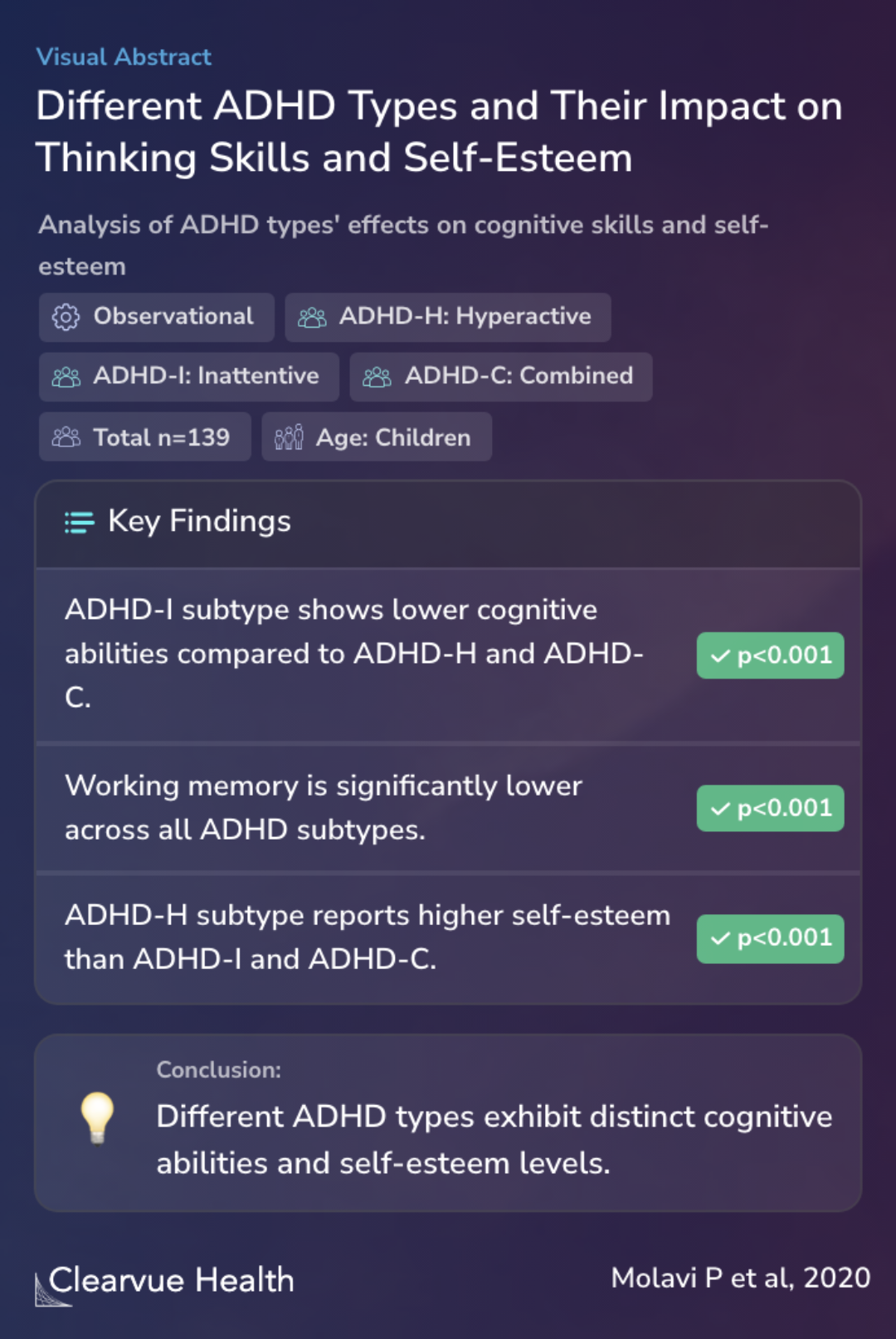ADHD subtype-specific cognitive correlates and association with self-esteem: a quantitative difference
Different ADHD Types and Their Impact on Thinking Skills and Self-Esteem
Molavi P, Nadermohammadi M, Salvat Ghojehbeiglou H, Vicario CM, Nitsche MA, Salehinejad MA

Objectives
Attention-deficit hyperactivity disorder, or ADHD, is a complex condition that affects many children. It shows up in different ways, which we call subtypes. Each subtype can affect a child's thinking skills and feelings about themselves. The authors of this study focused on these differences. They wanted to know how these ADHD subtypes, based on the Wechsler Intelligence Scale for Children scores, are connected to how kids think and feel about themselves. This is important because understanding these differences can help us support these children better.
Attention-deficit hyperactivity disorder (ADHD) is a major neurodevelopmental disorder with heterogeneous symptoms, subtypes, and cognitive deficits. Cognitive deficits are central to ADHD pathophysiology and one potential source of heterogeneity in ADHD. Subtype-specific cognitive corre...
Methods
The study looked at 139 kids with ADHD. They were split into three groups based on their symptoms: ADHD-H (mostly hyperactive), ADHD-I (mostly inattentive), and ADHD-C (a combination of both). Each child completed tests to measure their thinking skills and a survey about how they feel about themselves. This method helped the researchers see the differences between the subtypes in how these kids think and feel.
One hundred thirty-nine children with ADHD (80.6% boy, 19.4% girl) were categorized into the predominantly 'hyperactive (ADHD-H)', 'inattentive (ADHD-I)', and 'combined (ADHD-C)' subtype based on their symptoms and scores on the Kiddie Schedule for Affective Disorders and Schizophrenia (...
Results
The study found that kids with different types of ADHD have different levels of thinking skills and self-esteem. Specifically, children with the ADHD-I subtype tended to have lower thinking skills compared to those with ADHD-H and ADHD-C. Also, all ADHD subtypes showed challenges with working memory, a kind of thinking skill that helps us hold and use information in our minds. Interestingly, kids with the ADHD-H subtype reported feeling better about themselves than those with other subtypes. These results show us that the type of ADHD a child has can influence both how they think and how they feel about themselves.
We found a quantitative differentiation of cognitive abilities among ADHD subtypes with 'working memory' as the most compromised cognitive domain. ADHD-I had the poorest cognitive profile while ADHD-H scored highest in all cognitive domains. Importantly, cognitive abilities were negative...
Conclusions
This study tells us that we need to think about the specific type of ADHD a child has when we diagnose them and plan their treatment. The findings suggest that treatments focusing on improving thinking skills, especially working memory, could help all children with ADHD. Also, supporting children in school and through other interventions could be very important. It's clear that ADHD affects kids in different ways, and understanding these differences can help us provide better support and care.
ADHD subtype-specific symptoms, cognitive deficits, and self-esteem problems should be considered for precise diagnosis and effective and personalized treatment in ADHD in light of further supporting evidence and assessments. Cognitive interventions might be more compatible with and effe...
Key Takeaways
Context
The results of this study tie in with what we already know about ADHD. Previous studies, like those by Murphy KR and others, have shown that ADHD affects young adults' education and mental health differently based on their subtype. This highlights how ADHD impacts life beyond childhood.
Another study by Marshall RM found that children with ADHD without hyperactivity, had lower math scores. This suggests that specific ADHD subtypes can affect learning in unique ways, like in math.
Additionally, Lahey BB's research showed that ADHD symptoms can change over time, which affects how we should treat and understand the disorder.